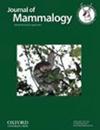To go or not to go: variable density-dependent dispersal in small mammals
IF 1.5
3区 生物学
Q2 ZOOLOGY
引用次数: 0
Abstract
Population density has been widely understood to be a key influencer of dispersal behavior; however, the generality of density-dependent (DD) dispersal in vertebrates is unclear. We conducted a review of the available empirical data on small mammal DD dispersal, distinguishing between the three dispersal stages: emigration, immigration, and transience (dispersal distance). We focused on small mammals because they are a well-studied, functionally similar group of vertebrates, with a distinct ecological importance. We also examined the effect of season, body mass, study length, and study type on the strength and direction of DD dispersal. The majority of emigration and dispersal distance studies reported negative density dependence, while immigration was mostly independent of density. No correlative patterns were detected; however, interpretation of the available data was hindered by inconsistencies in experimental and analytical approach across studies. Our results suggest that the three phases of the dispersal process may be influenced differently by density and highlight the importance of distinguishing between emigration, immigration, and transience when considering the effects of density dependence. As well, our study identifies several limitations with the current available data which limit the ability to compare DD dispersal behavior across systems, and calls for future investigations that consider all three phases of dispersal in the same system.去还是不去:小型哺乳动物的密度依赖性分散
种群密度被广泛认为是扩散行为的关键影响因素;然而,密度依赖(DD)扩散在脊椎动物中的普遍性尚不清楚。本文对小型哺乳动物DD扩散的现有经验数据进行了回顾,区分了三个扩散阶段:迁出、迁移和短暂(扩散距离)。我们之所以关注小型哺乳动物,是因为它们是一种被充分研究过的、功能相似的脊椎动物群体,具有独特的生态重要性。我们还研究了季节、体重、研究时长和研究类型对DD扩散强度和方向的影响。大多数迁移和扩散距离研究报告了负的密度依赖,而迁移大多独立于密度。未检测到相关模式;然而,由于实验和分析方法的不一致性,对现有数据的解释受到阻碍。我们的研究结果表明,分散过程的三个阶段可能受到密度的不同影响,并强调在考虑密度依赖效应时区分迁出,迁移和短暂性的重要性。此外,我们的研究还确定了当前可用数据的几个局限性,这些局限性限制了比较不同系统中DD扩散行为的能力,并呼吁未来的研究考虑同一系统中所有三个扩散阶段。
本文章由计算机程序翻译,如有差异,请以英文原文为准。
求助全文
约1分钟内获得全文
求助全文
来源期刊

Journal of Mammalogy
生物-动物学
CiteScore
3.30
自引率
5.90%
发文量
106
审稿时长
4-8 weeks
期刊介绍:
Papers are published on mammalian behavior, conservation, ecology, genetics, morphology, physiology, and taxonomy.
 求助内容:
求助内容: 应助结果提醒方式:
应助结果提醒方式:


